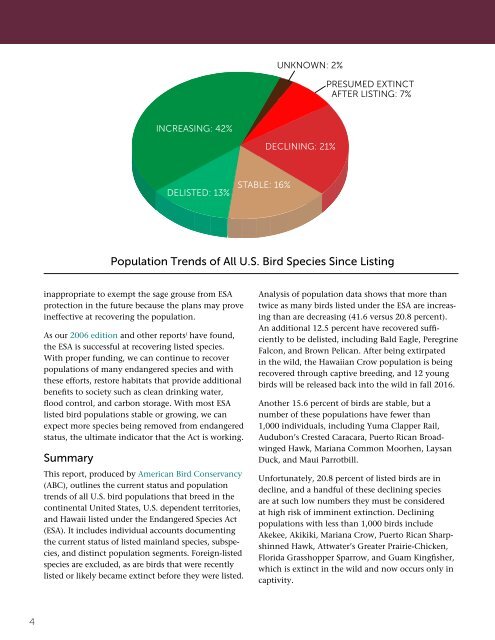ENDANGERED SPECIES ACT
2aczlws
2aczlws
You also want an ePaper? Increase the reach of your titles
YUMPU automatically turns print PDFs into web optimized ePapers that Google loves.
UNKNOWN: 2%<br />
PRESUMED EXTINCT<br />
AFTER LISTING: 7%<br />
INCREASING: 42%<br />
DECLINING: 21%<br />
DELISTED: 13%<br />
STABLE: 16%<br />
Population Trends of All U.S. Bird Species Since Listing<br />
inappropriate to exempt the sage grouse from ESA<br />
protection in the future because the plans may prove<br />
ineffective at recovering the population.<br />
As our 2006 edition and other reports i have found,<br />
the ESA is successful at recovering listed species.<br />
With proper funding, we can continue to recover<br />
populations of many endangered species and with<br />
these efforts, restore habitats that provide additional<br />
benefits to society such as clean drinking water,<br />
flood control, and carbon storage. With most ESA<br />
listed bird populations stable or growing, we can<br />
expect more species being removed from endangered<br />
status, the ultimate indicator that the Act is working.<br />
Summary<br />
This report, produced by American Bird Conservancy<br />
(ABC), outlines the current status and population<br />
trends of all U.S. bird populations that breed in the<br />
continental United States, U.S. dependent territories,<br />
and Hawaii listed under the Endangered Species Act<br />
(ESA). It includes individual accounts documenting<br />
the current status of listed mainland species, subspecies,<br />
and distinct population segments. Foreign-listed<br />
species are excluded, as are birds that were recently<br />
listed or likely became extinct before they were listed.<br />
Analysis of population data shows that more than<br />
twice as many birds listed under the ESA are increasing<br />
than are decreasing (41.6 versus 20.8 percent).<br />
An additional 12.5 percent have recovered sufficiently<br />
to be delisted, including Bald Eagle, Peregrine<br />
Falcon, and Brown Pelican. After being extirpated<br />
in the wild, the Hawaiian Crow population is being<br />
recovered through captive breeding, and 12 young<br />
birds will be released back into the wild in fall 2016.<br />
Another 15.6 percent of birds are stable, but a<br />
number of these populations have fewer than<br />
1,000 individuals, including Yuma Clapper Rail,<br />
Audubon’s Crested Caracara, Puerto Rican Broadwinged<br />
Hawk, Mariana Common Moorhen, Laysan<br />
Duck, and Maui Parrotbill.<br />
Unfortunately, 20.8 percent of listed birds are in<br />
decline, and a handful of these declining species<br />
are at such low numbers they must be considered<br />
at high risk of imminent extinction. Declining<br />
populations with less than 1,000 birds include<br />
Akekee, Akikiki, Mariana Crow, Puerto Rican Sharpshinned<br />
Hawk, Attwater’s Greater Prairie-Chicken,<br />
Florida Grasshopper Sparrow, and Guam Kingfisher,<br />
which is extinct in the wild and now occurs only in<br />
captivity.<br />
4


